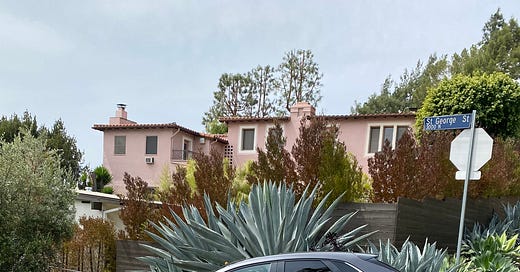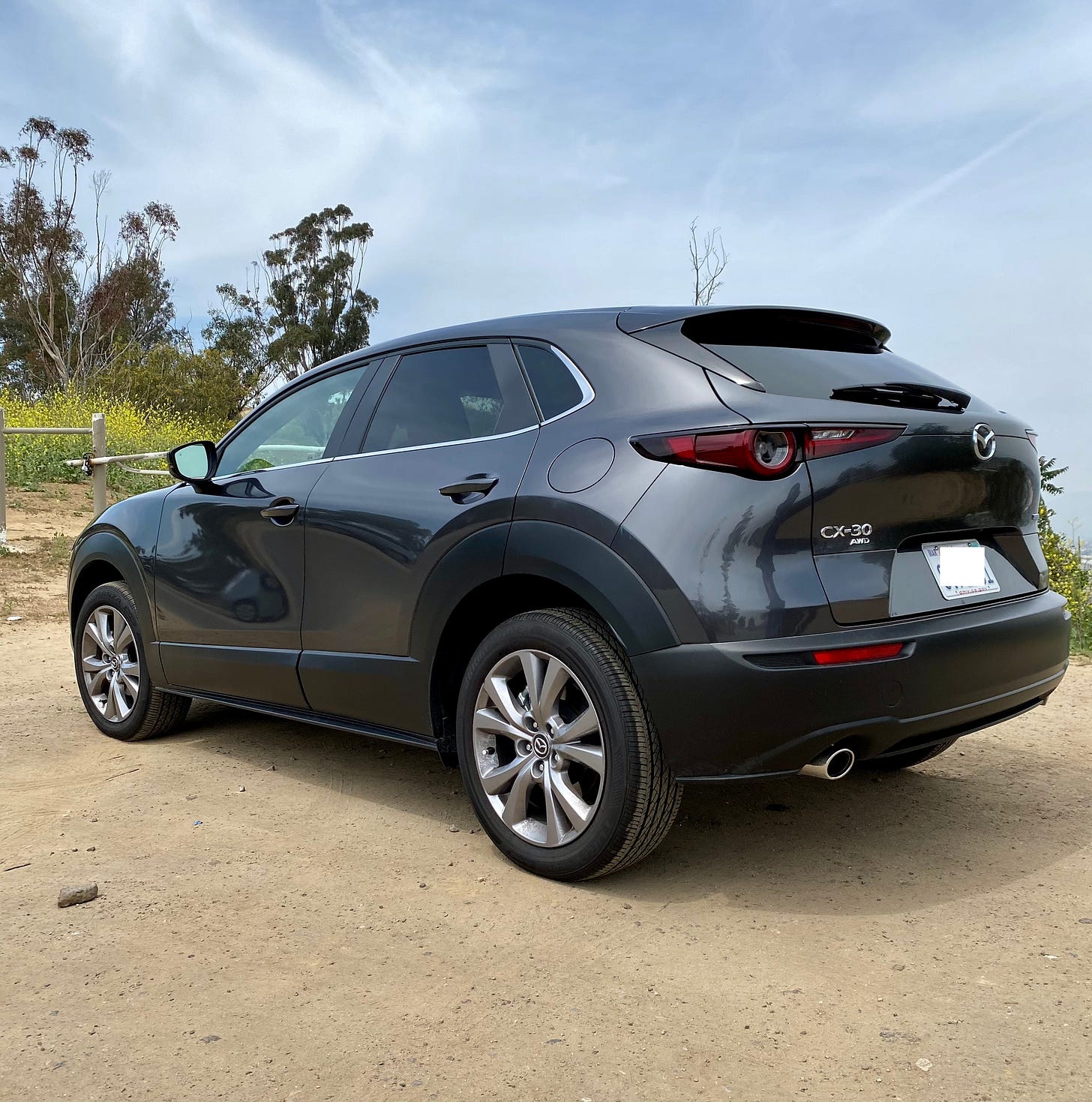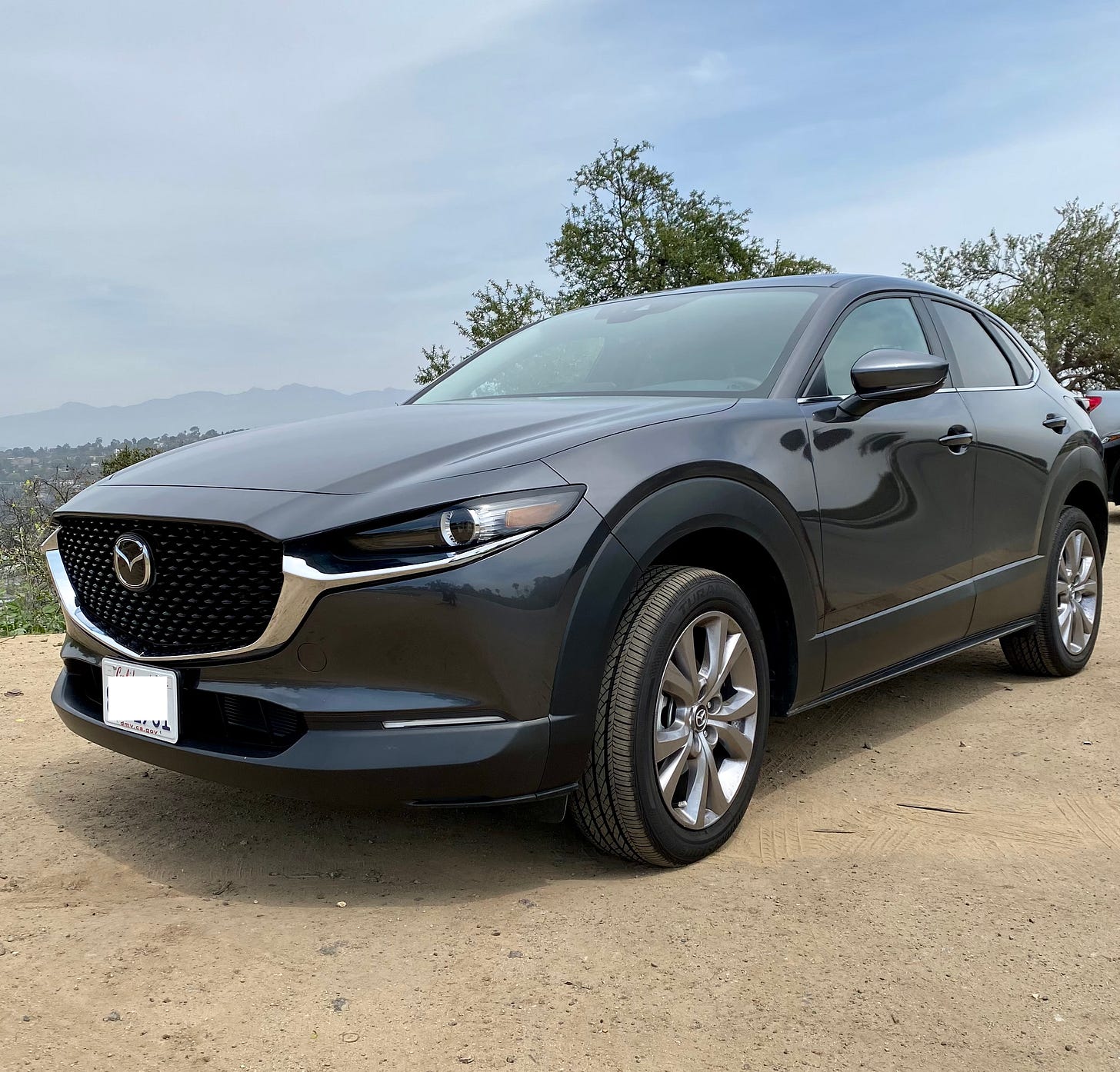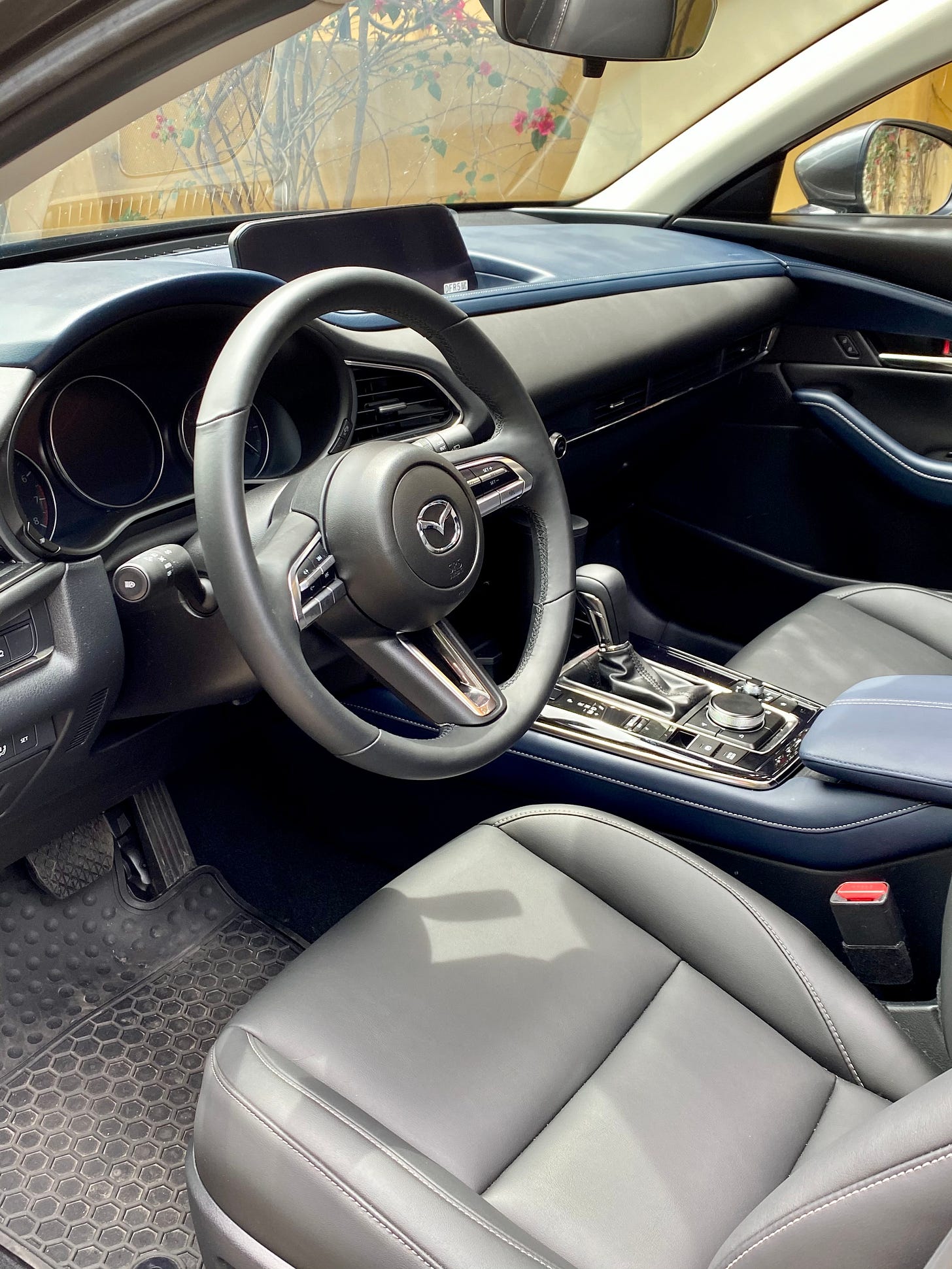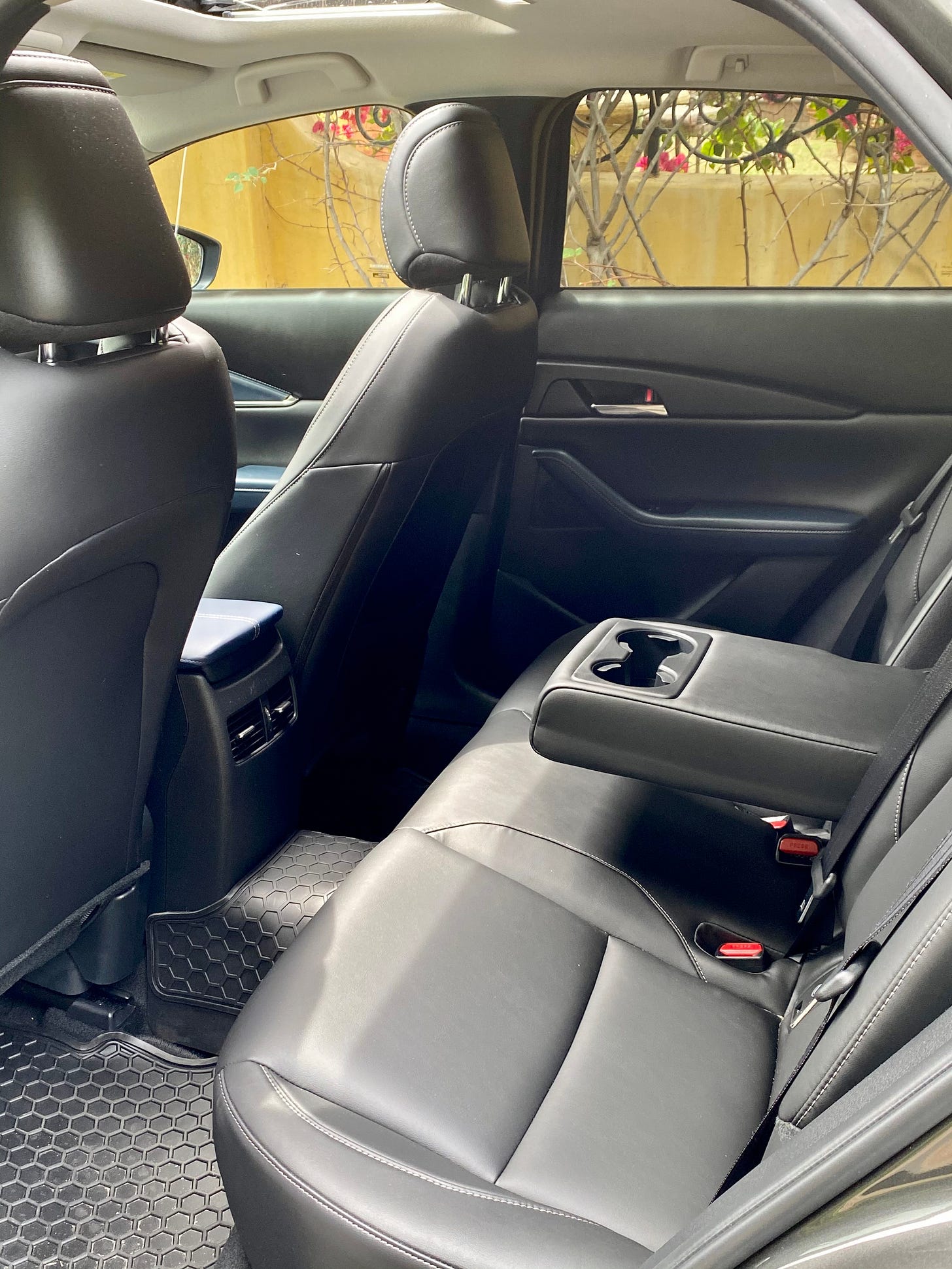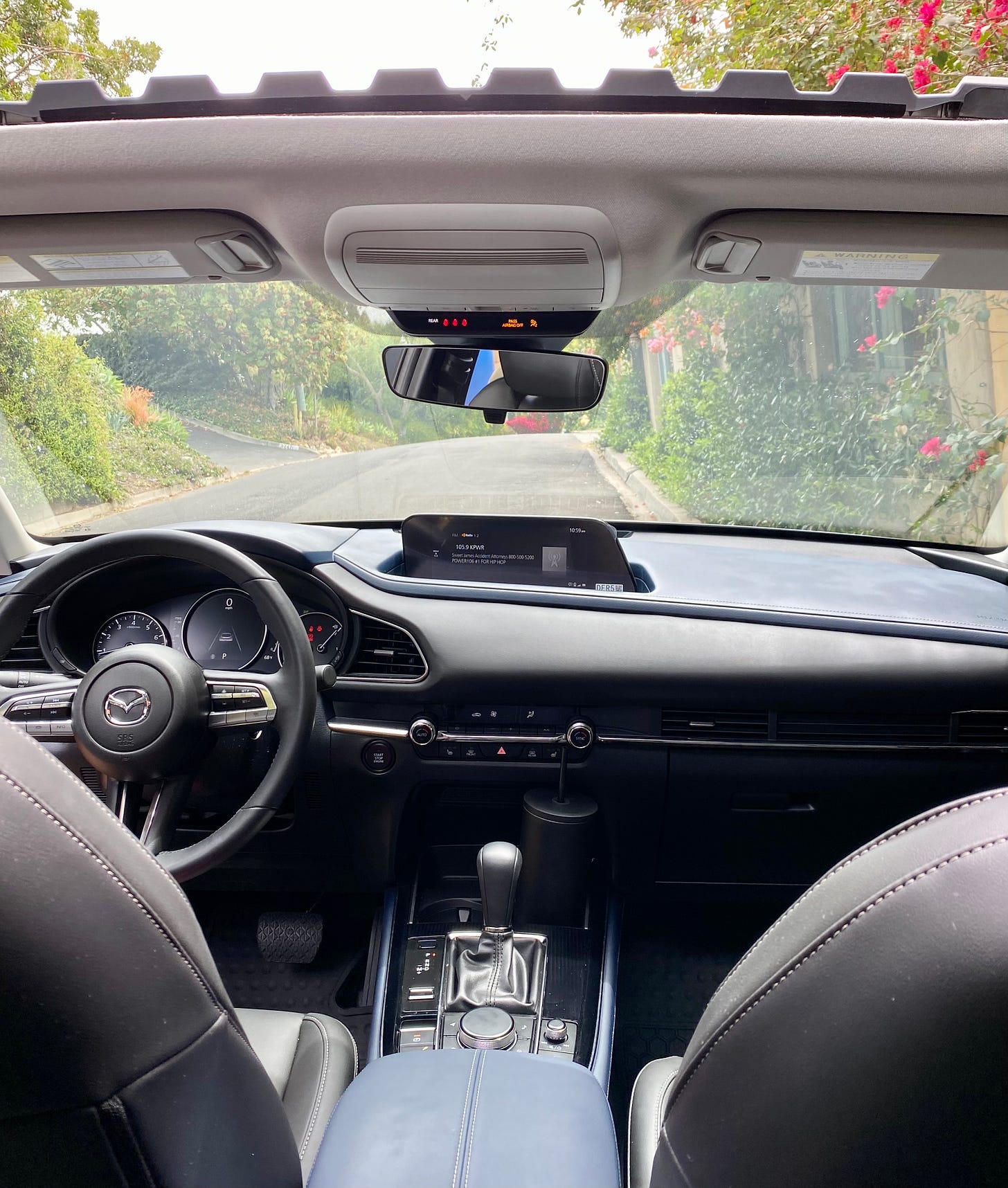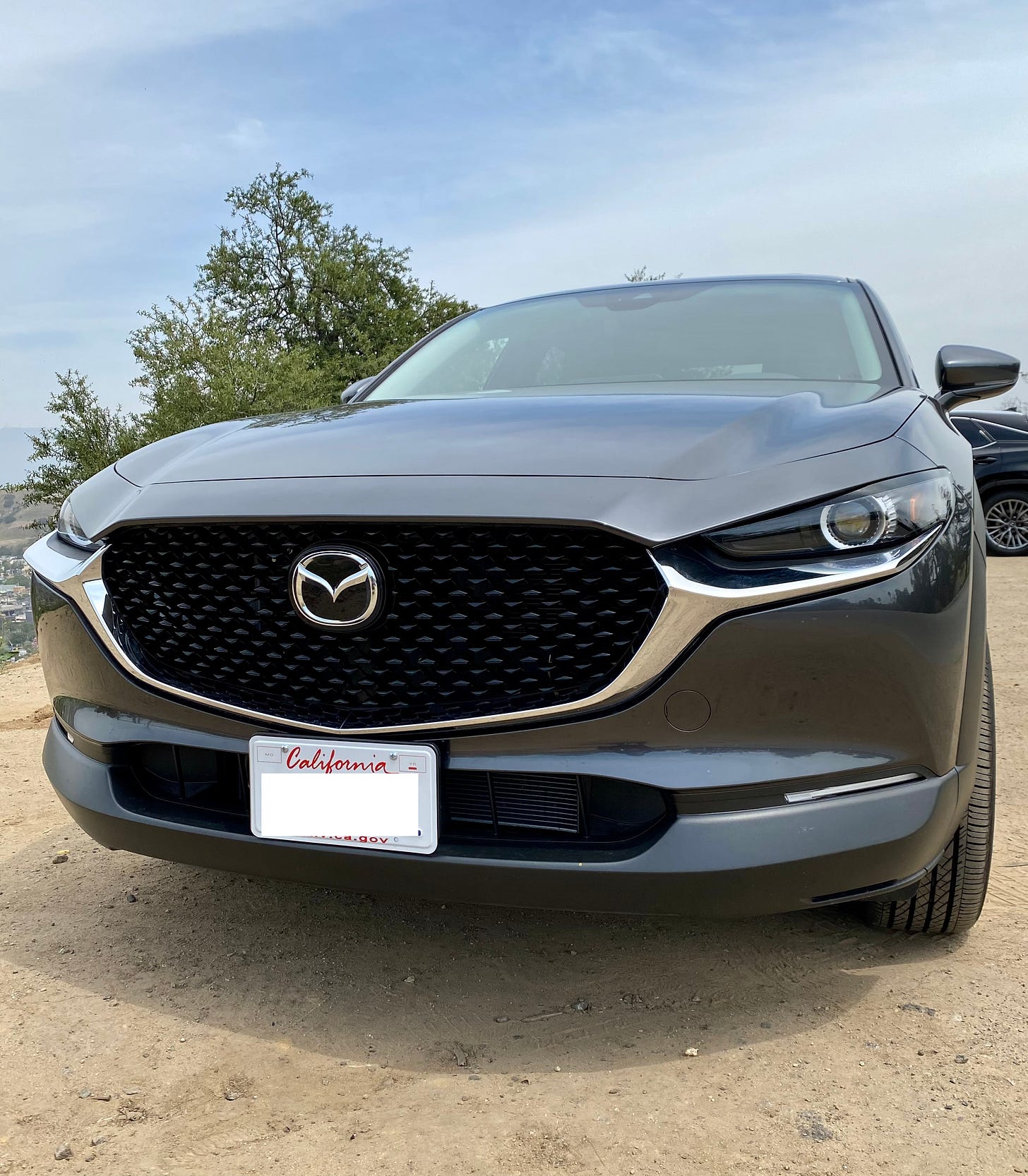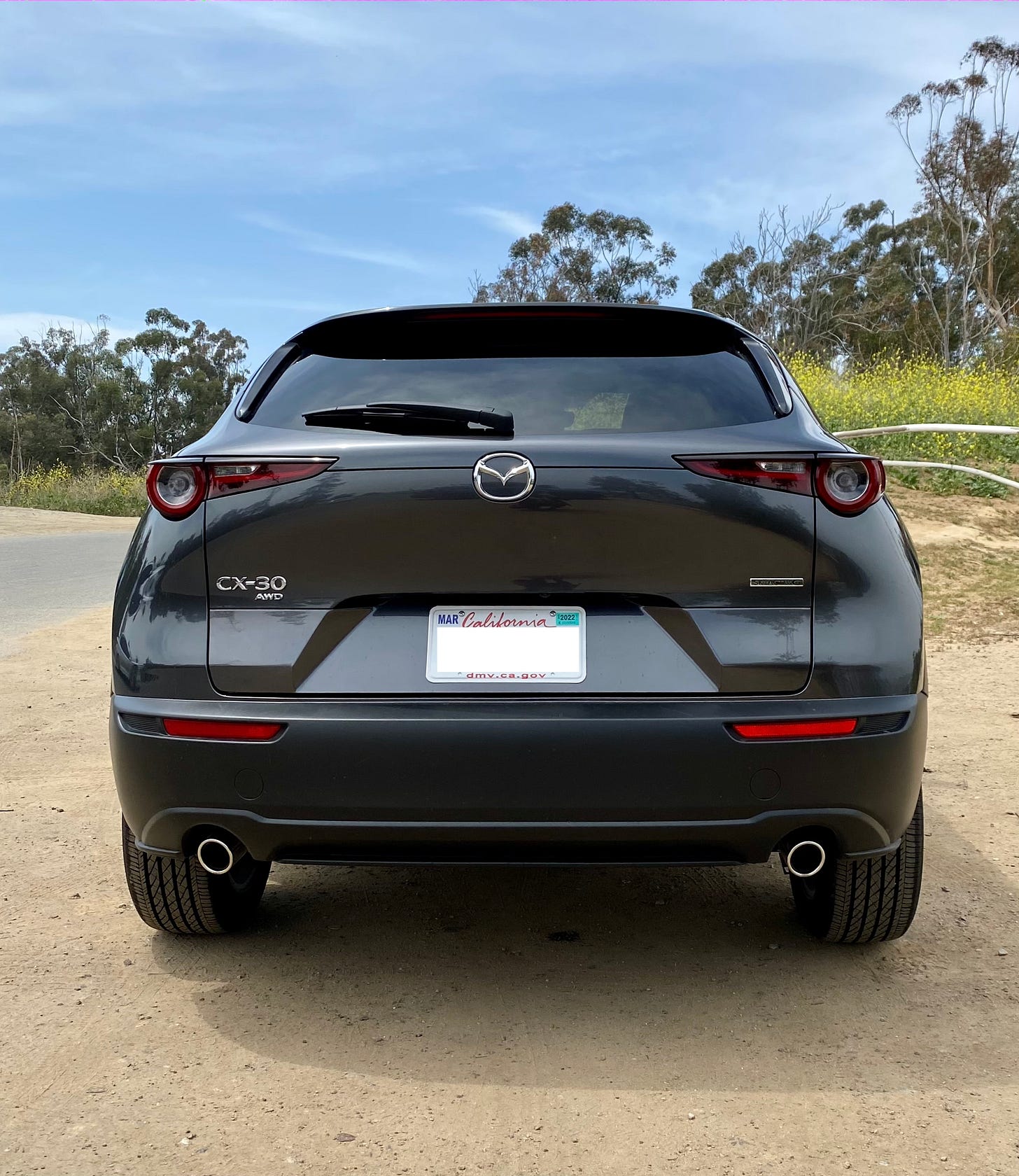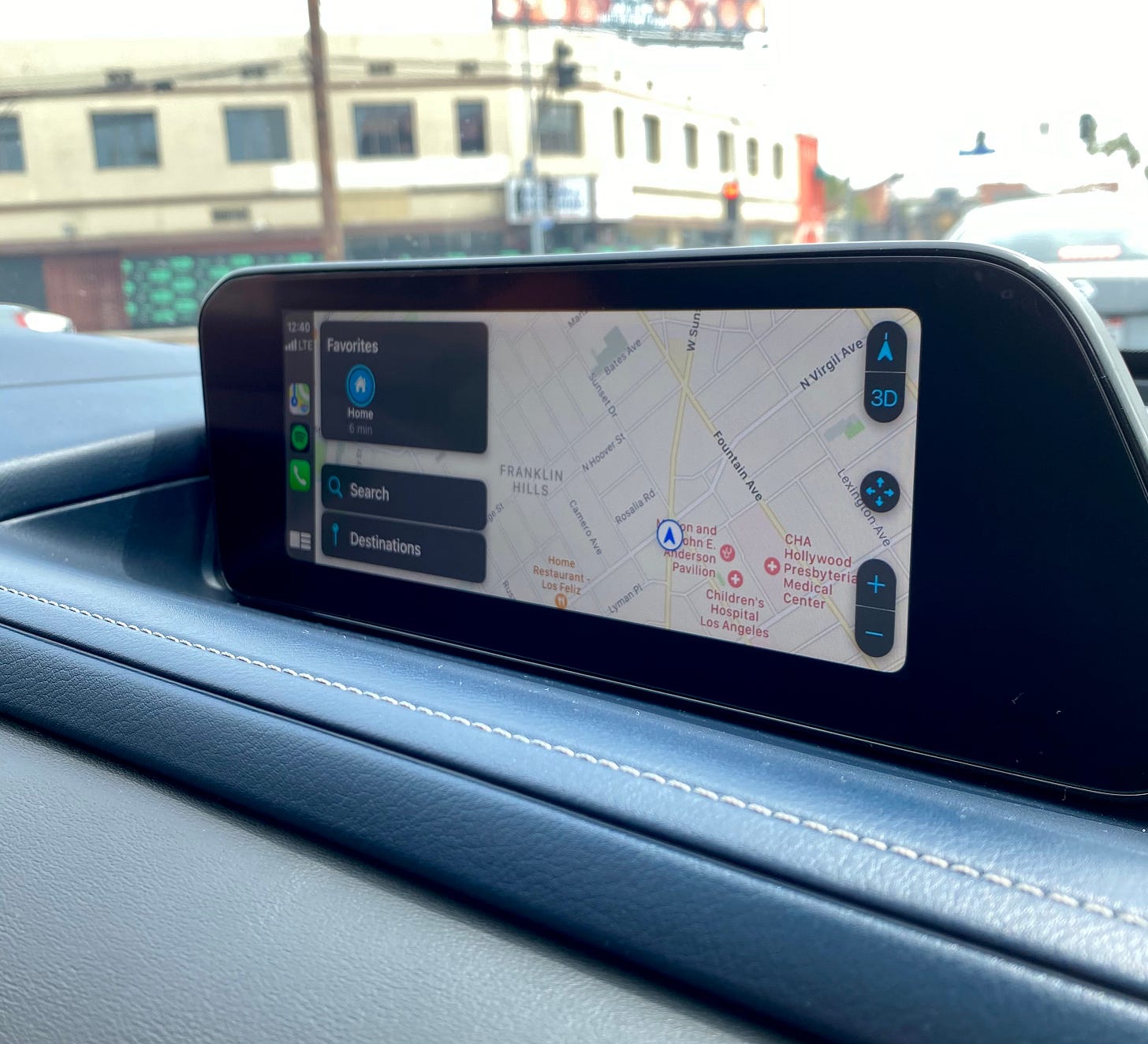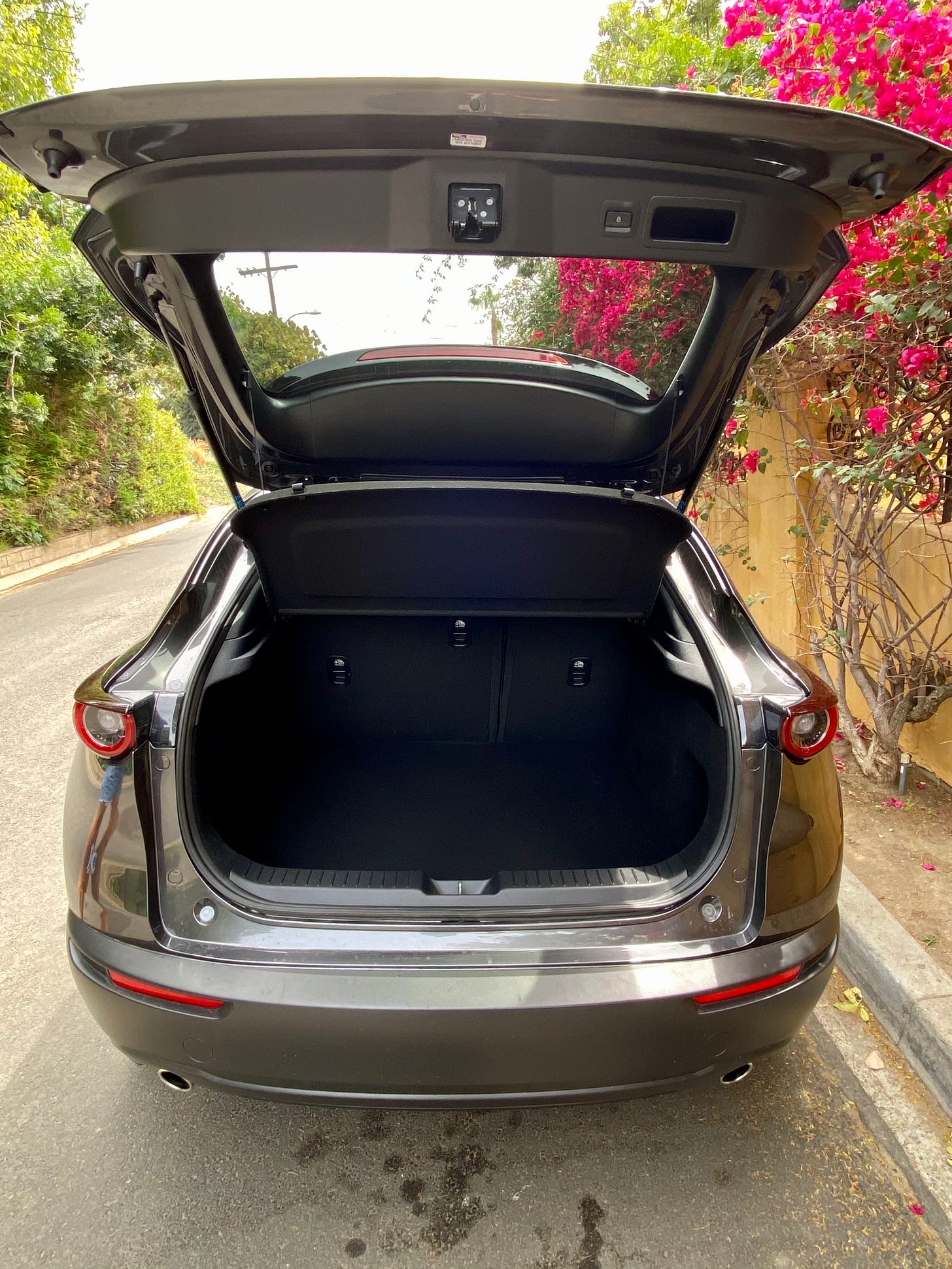2021 Mazda CX-30: Boring Gay Car Review
High design and packed with value, but a little light on power with one piece of key tech missing.
Recently one of my closest friends needed to find a new car very quickly. Her parameters? Something that felt luxury, with an AWD option, reasonable price, fairly roomy, and environmentally conscious. Immediately I knew I wanted to guide her into a CX-30 - but cross-pitched the RAV-4, Prius AWD, Subaru Crosstrek, Kia Seltos, and even a used Lexus NX. She landed on CX-30 based on the beautiful design, luxury feel, latest technology, and overall value.
Admittedly, when I first heard Mazda was making a CX-30 I thought, why? They have a CX-3, CX-5, and CX-9…why are in-between models even necessary? But every brand is doing it…options are king these days and I’d imagine it’s fairly cost-effective for brands to rework core platforms to create these middle options. So, if like many, you think the CX-3 is too small for you, and the extremely popular CX-5 is just a little too large…you might land on the CX-30. By the way, if cargo room is important to you, the CX-30 has 20.2 cubic feet of it, compared to the CX-3’s 17.8, and the CX-5’s 30.9. The CX-30 is essentially a handsome and lifted version of the Mazda3 (which, in wagon form, I’d argue is one of the most beautiful and affordable cars on the road today).
So what are the need-to-know stats? The CX-30 launched in 2020 as a brand new model, nothing came before it. It starts at $22K, maxes out at $29K, and although it just came out, you might be able to save a couple thousand getting one used. It has a 186 horsepower 2.5L 4-cylinder engine with 186 pound-feet of torque mated to a 6-speed automatic transmission. It gets 25 city and 33 highway MPG, which comes down to 24/31 if you opt for the AWD (which, by the way, my friend said impressed her during a recent trip to the snow). The car has a 13.5 gallon gas tank (always good to know to calculate what you might expect at the pump) and goes from 0-60 MPH in 8 seconds (not super fast, but manageable). To make up for the limited speed, Mazda recently launched a turbo model that makes 250 horsepower with a vastly higher 310 pound-feet of torque. Those are very respectable numbers, but that model ranges from about $30-35K in price depending on trim, at which point I’d be curious to cross-shop traditional luxury competitors (Lexus, Acura, etc.).
My friend opted for the CX-30 Preferred with AWD (only one tier below the fully loaded Premium). So let’s talk about how you might get there. The car has a $22K base, which includes a standard 8.8” media screen, CarPlay and Android, Mazda Connect (remote start, lock/unlock, vehicle status - free for 3 years…then $10/month), LED headlights, and taillights, rain-sensing wipers, 16” wheels and a suite of autonomous technologies, including lane departure warning, lane keep assist, radar cruise control with stop and go functionality, driver attention alert, and a rear camera.
Stepping up from the base to the Select ($24.5K) will add leatherette (which I feel is much needed), blind-spot monitoring and rear cross-traffic alert (which works really well), 18” wheels, dual-zone climate control, and advanced keyless entry. The Preferred ($26.5K) will add a moonroof, power driver’s seat, and heated front seats (yes God), and the top-of-the-line Premium ($28.7K) will add real leather seats, adaptive front lighting, a rear power liftgate, a Bose sound system upgrade with 12 speakers (vs. the base 8), a heads up display, and traffic sign recognition. One of my favorite features on the car was the two-tone color combo (my friend chose black and blue), which really elevated the style factor and made me feel like I was in a Lexus.
Materials and finish across the board felt upscale and much along the lines of the Lexus UX I recently drove, at quite the discount. But again, you’ll need to opt for at least the second trim up to get leatherette. The seats, by the way, were rather comfortable for a day drive around LA. As shown in my IG review (which is saved in my story highlights under “SUVs” for your rewatching pleasure), when a tall person has the front seats all the way back, it does become a bit cramped for a similarly tall person to sit behind them. It’s doable if both people compromise a bit, but you’ll want to opt for a larger car if you have tall friends and family. If your friends are average heights or you literally drive them a couple of times per year, don’t consider them. When’s the last time one of your friends paid your car payment…I’m just saying.
Some standout features included the digital visualization for blind-spot and lane-keep assist on the dash (felt upscale), in addition to the autonomous technology suite. One glaring deficiency was that the car does not have an option that actually steers for you (which Toyota and Hyundai include in their base safety suite). Those companies call that technology “lane following” or “lane tracing” assistant, which will generally steer the car for you on subtle curves. It’s by no means perfect, but I have come to expect it in most cars (how quickly we become spoiled…this tech didn’t even exist in the mainstream ten years ago). The CX-30 does have lane-keep assist which will warn you when you veer out of the lane and gently try to push you back. But it will do nothing even on a mild curve to steer itself - it simply does not have that technology.
On the flip side, I will say I was extremely impressed with the car’s base sound system which features “Mazda Acoustics” - technology that optimizes sound distribution evenly throughout the cabin. If you told me this 8-speaker system was the upgraded 12-speaker Bose system, I would believe you. It’s really nice that Mazda includes this level of quality in the standard car. The RAV-4 I drove, by comparison, had a very subpar sound system. Speaking of impressed - both the size of the infotainment screen and the quality of the graphics were very impressive - both standard. It seriously felt like something you would get in a Lexus or BMW these days (if not better on the size front). Some of the base media screens in luxury cars are even smaller.
I love the butt on this thing. Thick with it! But back to the review…when it came to the driving experience, the car is not particularly fast. It has a sport mode like most cars that will make it feel a little more dynamic if you need a bit of a rush. But you might want the turbo if your cars need to pack a punch. That said, the MPG is pretty good for a crossover, and the lower horsepower is to thank for it. The engine can get rather loud when you push the car but has a pleasant “purr” (as my friend characterized) around the city. You can compare that to the more “thrashy” engine noise of a base Toyota, for instance. This sounds like I’m completely shading Toyota - but I actually like the RAV-4, and you can check my IG stories for that on your way to the CX-30 review. One thing I also noticed (at least once) was the transmission jumping a bit or being confused about the gears when pushed too quickly in sport mode. Almost as if to say “whoa there - didn’t expect that, what gear am I in now?” That is something that might be cured with an 8-speed transmission…but that’s not really my area of expertise and you’re unlikely to notice that too often.
Wrapping up - the car comes with a 3 year/36,000 mile warranty and 5 year/60,000 mile powertrain warranty. Not the best in the game, but not bad either. Ultimately, Mazda’s are comparable to Toyota and Honda reliability and I wouldn’t be too stressed about maintenance issues or costs anywhere in the near term, which is definitely a plus compared to luxury options. If you find a CPO model, it will add another year and 12,000 miles of warranty with $0 deductible should you need a repair during that period. Those CPO deductibles (which can be $50-100 based on the brand) have always come as a surprise to me when I needed them.
Ultimately, for my money, this car does a lot of things well. I clearly recommended it to my friend, which is why I was able to do this review. I think that in a sea of crossover options, this one stands out as a unique and beautiful choice full of value and great for city and suburban drivers alike. Three reasons to buy: (1) more visually appealing than many of the competitors out; (2) currently more unique than the ubiquitous CX-5 and RAV-4’s of the world; and (3) proven Mazda reliability and access to a luxury feel for the price. Three reasons not to buy: (1) underpowered and not particularly sporty; (2) the higher trims get pricey enough to want to cross-shop higher-end competitors; and (3) lack of a basic self-steering technology that other competitors include. Hopefully, you enjoyed this review - hit the heart icon below to let me know you did, and please do head to my IG story highlights under SUV’s to see more on the CX-30. -Lex

